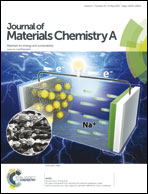Synthesis of flower-like CuS hollow microspheres based on nanoflakes self-assembly and their microwave absorption properties†
Abstract
Flower-like CuS hollow microspheres composed of nanoflakes have been successfully prepared via a facile solvothermal method. The crystal structure, morphology and microwave absorption properties of the as-synthesized products were characterized by X-ray diffraction (XRD), scanning electron microscopy (SEM), transmission electron microscopy (TEM) and a network analyser. The effects of reaction temperature, concentration of the reagents and reaction time on the structures and morphologies of the CuS products were investigated using XRD and SEM techniques. A plausible mechanism for the formation of hollow architectures related to Ostwald ripening was proposed. The CuS/paraffin composite containing 30 wt% CuS hollow microspheres shows the best microwave absorption properties compared with other CuS/paraffin composites. The minimum reflection loss of −31.5 dB can be observed at 16.7 GHz and reflection loss below −10 dB is 3.6 GHz (14.4–18.0 GHz) with a thickness of only 1.8 mm. The effective absorption (below −10 dB, 90% microwave absorption) bandwidth can be tuned between 6.2 GHz and 18.0 GHz for the absorber with a thin thickness in the range 1.5–4.0 mm. The results indicate that the microwave absorption properties of flower-like CuS hollow microspheres possess the advantages of broad bandwidth, strong absorption, lightweight and thin thickness are superior to those of other absorbing materials.


 Please wait while we load your content...
Please wait while we load your content...